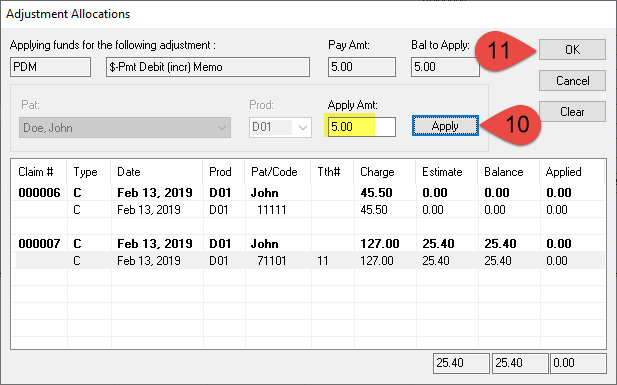Description
A Payment Debit Memo (PDM) is used in conjunction with a Payment Credit Memo (PCM) to adjust payments. They are offsetting adjustments, always used together for the same amount of money.
*It is recommended that all credits be left in held or unapplied and not applied to individual treatment lines, creating a credit on a claim.
This adjustment is only used to move an applied credit (attached to a claim) from one family member to another on the same account. (for example: Mom owes $5.00 on a claim and Son has a $5.00 credit on a claim and you need to move the credit to Mom’s ledger to make the family account balance at zero. A PDM will need to be applied for $5.00 to the son’s claim (increase) and a PCM will need to be applied to the Mom’s claim (decrease) for $5.00 making the claim balances on the account zero) The Payment Debit Memo increases the balance on the account as well as the accounts receivable. This adjustment does NOT affect deposit.
Step-by-Step
- You must decide whether this is a patient or insurance type adjustment. Click the appropriate choice.
- The date will appear automatically. Tab and use the pull down in the Balance area, highlight Increase. Tab and use the pull down in the Code area to highlight PDM $-PMT Debit (incr) Memo.
- Tab and type in the amount that you want to increase the balance by.
- The Payer area will need to show the insurance company if this is an insurance type adjustment. You can choose this by clicking on the … box and selecting the one you want. If this is a patient type adjustment (it will default to the patient name selected when opening the patient file at the beginning of this adjustment) but can be changed by clicking on the arrow down button and highlighting the appropriate patient.
This adjustment WILL NOT affect deposit. Be sure there is NOT a check mark in the Affect Today’s Deposit Box. - Use the pull down in the Bank area and select the bank that the payment was originally entered to.
- Click Save.
Additional Resources
Adjustment Training Video – A more in-depth demonstrations of transaction adjustments.




